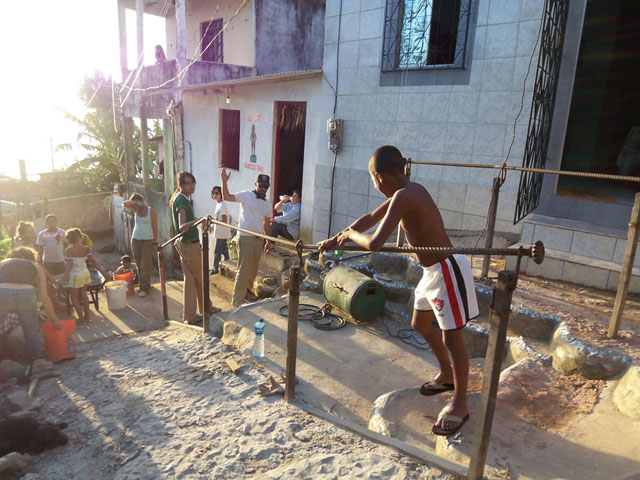Meghan Walsh’s ongoing work consists of a series of design build studios for small rural Brazilian communities and since 2006, Meghan has taken students to this outlying rural area of Plataform. Working with Jorge Sampião, a Pae de Santo priest of Candomblé, the traditional Afro-Brazilian religion at the root of most of Brazilians artistic, cultural, and culinary traditions, the studios focused on a primary public circulation zone and small gathering space for the village adjacent to Jorge’s terreiro, his live/work studio. Jorge is both a personal friend and respected spiritual leader. He has been a part of the Brazil Studio giving lectures and discussions about Candomblé, and explaining the orixas (gods and goddesses of the faith). The path construction work created easier residential access to the giant plaza at the top of the slope where community ceremony and socializing occurs. After repairing a broken sewage pipe along the steeply sloping dirt path in 2006, the students constructed a stair made of recycled tires. While working at this site, it became apparent that the small projects over time could make more of a difference than finding new sites each year. Gaining a clearer understanding between the equal importance of relationship building to physical architectural work, we realized that the year-to-year long-term relationships would result in deeper exchanges creating further opportunities. In 2007, the work on the path continued. Addressing community feedback, the students constructed a parallel path allowing easier access for wheelbarrows and “finished” the area in front of the terreiro. Metal handrails were added and the sacred entrance to the terreiro was framed by totems, signifying the most important orixas. In 2008 we will move up the hill from the terreiro. The program is almost entirely funded by the students' tuition, covering the faculty expenses. The projects are built with the students’ own money, approximately $70 each, less than a studio model.
Others who are involved with the studio include the following. Jack Sanders, who was Sambo Mockbee’s “Clerk of the Works” at the Rural Studio in Alabama, now teaches the design/build curriculum. Wesley Days leads the students’ initial cultural orientation. He is working towards his PhD in World Arts and Culture and is a 7-year mediator at the Seeds of Peace camp in Maine. He speaks fluent Portuguese and is intimately familiar with the Afro-Brazilian traditions of capoeira and Candomblé. Chico Rocha is a Brazilian architect who was born in Salvador, and practices in an office based in Recife and Sao Paolo. Chico leads the students in an architectural orientation at the beginning of the course. Lula Marcondes, also a Brazilian architect with a Master in Architecture from the University of Texas Austin, participated in 2007 as a leader for the initial student design charette and helped with the building of the “totems”. Adriana Dias, Marcio de Abreu, and Paula Gomes, contribute their historical and sociological expertise, lecturing about the history, economics, and culture of Brazil, focusing on the Afro-Brazilian cultural history. |

